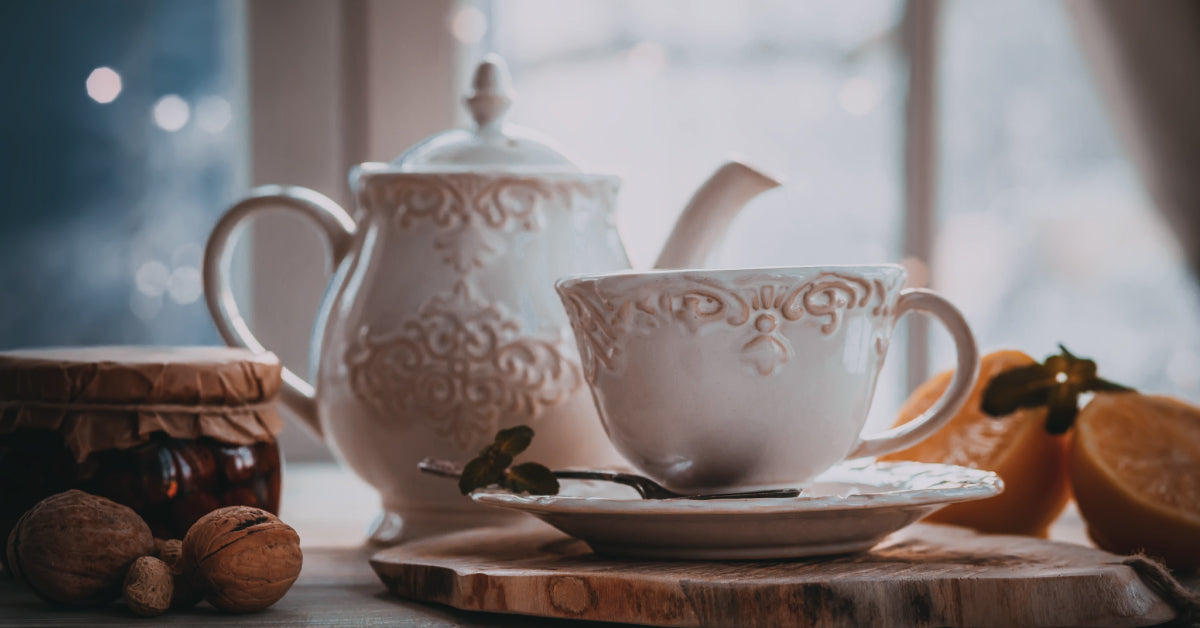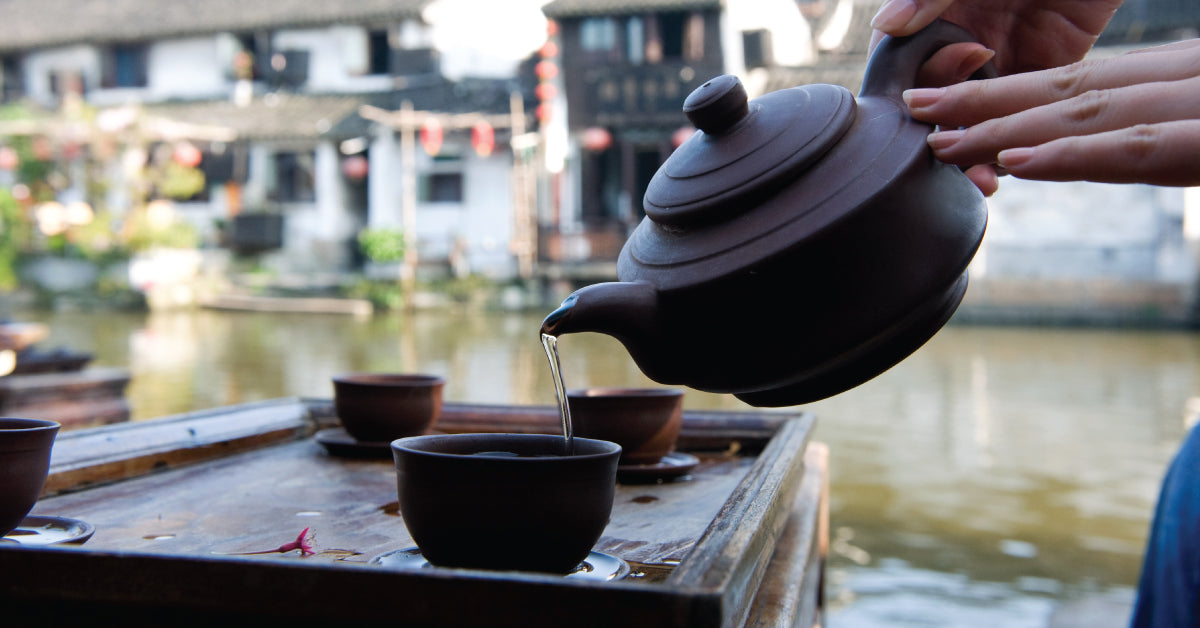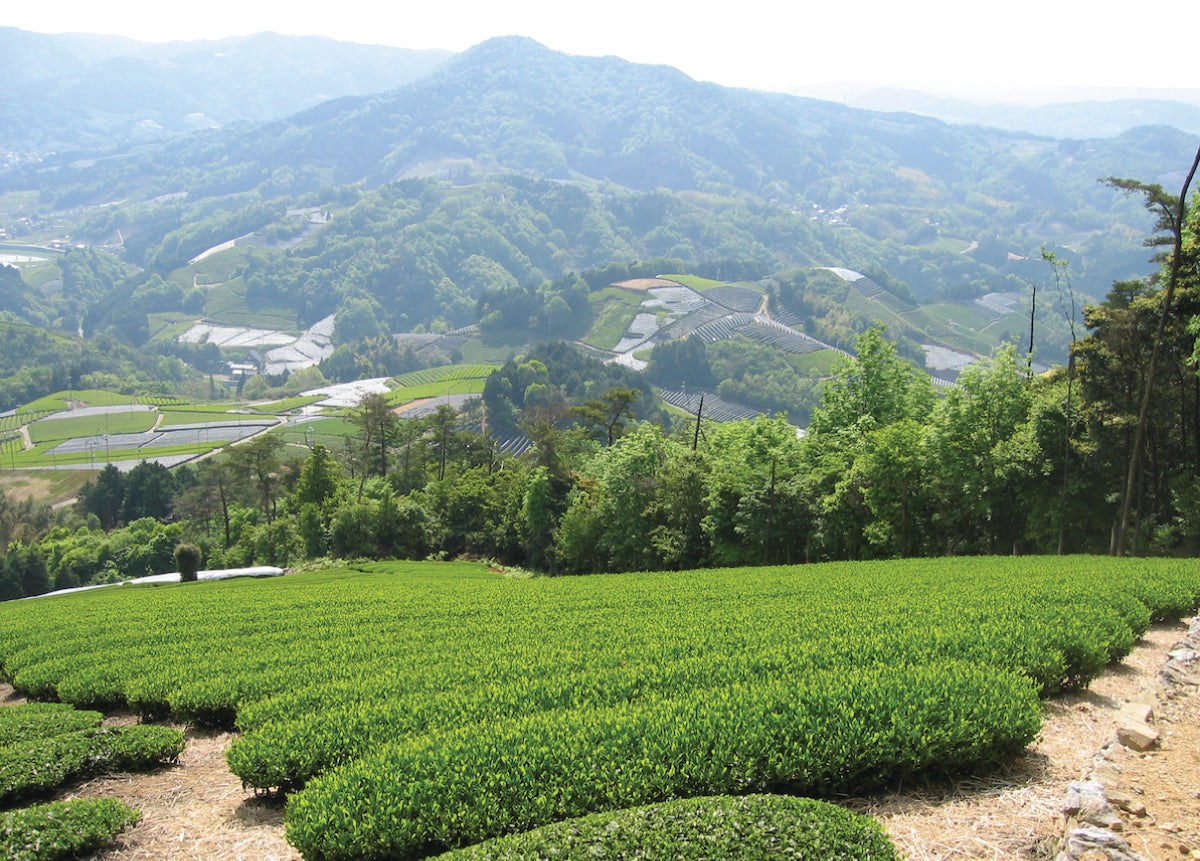There are two different ways to decaffeinate tea. At Harney and Sons, we use Carbon Dioxide (CO2) and Ethyl Acetate to make our decaf teas. Read on to learn more about our decaffeination process.

What Is the Difference Between Decaffeinated Tea & Caffeine Free Teas?
All teas made from Camellia Sinensis contain natural levels of caffeine. Caffeine is one of many self-defense chemicals that a tea uses to defend itself in this cruel world. Pound for pound there is more caffeine in tea than coffee, but who drinks a pound of tea? So cup for cup, tea is much less. In fact, you have to drink 3 cups of tea to get the same amount of caffeine as a cup of coffee.
Different parts of the tea leaves have different levels of caffeine. The delicious but defenseless tea buds have the most, green teas have slightly less and black teas even less. Of course, you steep black tea longer than green tea, so it is a bit complicated. Still, it is correct to say that there is more caffeine in white tea than black tea. The decaffeination process almost eliminates all of the caffeine.
Caffeine-free "teas" are not teas at all but blends of herbs, flowers, spices and dried fruit. When there is only a single ingredient, such as our Peppermint, these are referred to as Tisanes.
The Carbon Dioxide (CO2) Tea Decaffeination Method
The Carbon Dioxide (CO2) Tea Decaffeination Method, is how we decaffeinate our loose teas. Choosing to use this process ensures that we don’t lose the flavors and health benefits you love in our caffeinated teas when we remove the caffeine. When put through this process, our tea leaves are placed with naturally occurring gas, CO2, at a high pressure and high temperature. The carbon dioxide reaches a “super-critical state” where CO2 becomes almost a liquid solvent, and it attracts the caffeine molecules and removes them from the tea. Since flavor molecules are larger than caffeine molecules, they remain intact so the flavor of tea remains the same.

The Ethyl Acetate Decaffeination Method
Ethyl acetate is used to decaffeinate the tea found in our teabags. During this process, the molecules of caffeine bond to the molecules of ethyl acetate and are removed. Our customers prefer this method for our teabags.
The Water Processing Decaffeination Method (Swiss Water Method) and the Methylene Chloride Decaffeination Method
There are 2 other methods used for hard coffee beans, but these methods do not work for fragile tea leaves - the Water Processing Decaffeination Method, also known as the Swiss Water Method, and the Methylene Chloride Decaffeination Method.
DIY Decaffeination Method
Many tea lovers believe that if they steep their favorite caffeinated tea, dump the water, then steep again it will decrease the amount of caffeine in the cup. Unfortunately, this is a bit of an old wives tale. Studies show that tea keeps giving off caffeine for about 8 minutes. This method is not recommended as it dilutes the flavor of your tea.
No matter your reason for drinking caffeine-free tea, whether it’s doctor’s orders or sleeplessness, you can find a flavor of decaf tea you’ll love at Harney & Sons. Want to learn more about our teas and our process? Visit these quick-reads below:





16 comments
maria
I like your tea but since I drink tea daily I need to find a non chemical decaf tea process for both loose leaf and bags, I am done with buying random brands that use chemicals, once I find 2 or 3 that are chemical free that is what I will buy and I don’t care what the price is , I hope you go chemical free and advertise that on your packaging.
I like your tea but since I drink tea daily I need to find a non chemical decaf tea process for both loose leaf and bags, I am done with buying random brands that use chemicals, once I find 2 or 3 that are chemical free that is what I will buy and I don’t care what the price is , I hope you go chemical free and advertise that on your packaging.
Leslie
I realize this was published several years ago but thought I’d also comment that I prefer the CO2 method. I LOVE your hot cinnamon spice tea but have to watch caffeine intake. This tea makes a phenomenal latte that I love to sip at while reading a book at night but I have to use the decaf version. Unfortunately, I’ve always felt the decaf sachet tastes a bit off compared to the regular (loose). Now I know why I’m always a little disappointed when I brew the decaf. I love the convenience of the sachets but I guess I’ll be switching to loose decaf as well once I’ve gone through my stash. I do love loose leaf but sometimes it’s much easier to just use a sachet/bag, especially when traveling!!
I realize this was published several years ago but thought I’d also comment that I prefer the CO2 method. I LOVE your hot cinnamon spice tea but have to watch caffeine intake. This tea makes a phenomenal latte that I love to sip at while reading a book at night but I have to use the decaf version. Unfortunately, I’ve always felt the decaf sachet tastes a bit off compared to the regular (loose). Now I know why I’m always a little disappointed when I brew the decaf. I love the convenience of the sachets but I guess I’ll be switching to loose decaf as well once I’ve gone through my stash. I do love loose leaf but sometimes it’s much easier to just use a sachet/bag, especially when traveling!!
Joe Zygala
In response to Mary Jane Wheeler who posted on February 7, 2022 at 8:22 am
The sachets are not tea bags, which contain broken leaves. The sachets contain whole leaf tea which would have been decaffeinated via the CO2 method. I doubt she will see my posting, but others may see it and now understand the difference.
In response to Mary Jane Wheeler who posted on February 7, 2022 at 8:22 am
The sachets are not tea bags, which contain broken leaves. The sachets contain whole leaf tea which would have been decaffeinated via the CO2 method. I doubt she will see my posting, but others may see it and now understand the difference.
Penny
I have always wondered why my tea bag’s taste so different from my loose leaf, now I know. I will be buying my bagged from Fraser Teas. They use the Co2 method for all of their teas.
I have always wondered why my tea bag’s taste so different from my loose leaf, now I know. I will be buying my bagged from Fraser Teas. They use the Co2 method for all of their teas.
Katya
Got your decaf black tea with vanilla and loved the taste. Then got curious about decaf process and apparently it’s not good for pregnant people. I wish I knew it before I bought it in-store. Switching back to decaf (Swiss water method) Kicking horse coffee, oatmilk and water…
Got your decaf black tea with vanilla and loved the taste. Then got curious about decaf process and apparently it’s not good for pregnant people. I wish I knew it before I bought it in-store. Switching back to decaf (Swiss water method) Kicking horse coffee, oatmilk and water…
Barbara
I, too, would like to add my displeasure to your policy of the way you decaffeinate your tea bags. Why are they not decaffeinated in the same way as your loose tea? I have used decaffeinated tea for many years are I am just now learning about your method…not happy about that!
I, too, would like to add my displeasure to your policy of the way you decaffeinate your tea bags. Why are they not decaffeinated in the same way as your loose tea? I have used decaffeinated tea for many years are I am just now learning about your method…not happy about that!
Lori
I,too, am disappointed that you use methyl acetate in the decaf tea bags. I will be switching to loose decaffeinated tea to avoid this chemical. What is the reason for this?
I,too, am disappointed that you use methyl acetate in the decaf tea bags. I will be switching to loose decaffeinated tea to avoid this chemical. What is the reason for this?
Abigail
I’ve very curious to know where you get your numbers for the caffeine levels. You mention that white tea has the highest caffeine content, followed by green, then black coming in at the lowest caffeine content. This is the first I’ve EVER seen this stated, and would love to know what research or studies were done to come to this conclusion. If you can share your findings directly with me I’d be most grateful!
I’ve very curious to know where you get your numbers for the caffeine levels. You mention that white tea has the highest caffeine content, followed by green, then black coming in at the lowest caffeine content. This is the first I’ve EVER seen this stated, and would love to know what research or studies were done to come to this conclusion. If you can share your findings directly with me I’d be most grateful!
KK
Thank you for the transparency. I love tea, but like many am kept awake when I drink it in the evening. So I came here to see if you have decaf. I’m grateful you decaf your loose teas using the CO2 method, as I’m highly allergic to teas that use the ethyl acetate method. Please don’t ever change the way you decaf loose tea, and hopefully, you will choose to use the CO2 method for all your teas one day.
Thank you for the transparency. I love tea, but like many am kept awake when I drink it in the evening. So I came here to see if you have decaf. I’m grateful you decaf your loose teas using the CO2 method, as I’m highly allergic to teas that use the ethyl acetate method. Please don’t ever change the way you decaf loose tea, and hopefully, you will choose to use the CO2 method for all your teas one day.
Easter
Jasmine Black Tea Decaffeinated (CO2)?
My friends and I just love your Jasmine Black Tea but we are all having trouble sleeping.
Do you carry a Black Jasmine Tea Decaffeinated? I sure hope that if you don’t carry it – that soon you will consider to add this product to your wonderful line of teas.
Jasmine Black Tea Decaffeinated (CO2)?
My friends and I just love your Jasmine Black Tea but we are all having trouble sleeping.
Do you carry a Black Jasmine Tea Decaffeinated? I sure hope that if you don’t carry it – that soon you will consider to add this product to your wonderful line of teas.
Mary Jane Wheeler
Was about to place my order for Decaf Hot Cinnamon Spice Sachets when I read that ethyl acetate is used during the decaffeination process. Yikes! Not healthy. So sorry to read this. This tea had become an important part of my morning routine.
Please reconsider using the carbon dioxide method.
Thank you.
Was about to place my order for Decaf Hot Cinnamon Spice Sachets when I read that ethyl acetate is used during the decaffeination process. Yikes! Not healthy. So sorry to read this. This tea had become an important part of my morning routine.
Please reconsider using the carbon dioxide method.
Thank you.
Mel
I also would prefer you used the co2 method for all your tea. Especially at this price point. I wouldn’t buy the tea bags knowing thats the method you use. I just prefer the co2 method. I will have to look at your loose leaf options but prefer tea bags for convenience.
I also would prefer you used the co2 method for all your tea. Especially at this price point. I wouldn’t buy the tea bags knowing thats the method you use. I just prefer the co2 method. I will have to look at your loose leaf options but prefer tea bags for convenience.
Jill Carr
I, too, am curious why you think teabag users prefer the ethyl acetate method? I use both loose tea and teabags at different times, and would prefer the CO2 method for both.
I, too, am curious why you think teabag users prefer the ethyl acetate method? I use both loose tea and teabags at different times, and would prefer the CO2 method for both.
Meredelune
Is this method healthy? Does it remove the benefits of tea. I have to drink decaf for health reasons.
Is this method healthy? Does it remove the benefits of tea. I have to drink decaf for health reasons.
Melesa
First, let me say I LOVE your tea and have been ordering for awhile. Lately, I have been trying to eat healthier and cleaner removing unwanted chemicals and perservatives from my diet. Then I started researching decaffination methods. Why do you use the Ethyl Acetate Decaffeination Method for your tea bags? I am reading that Ethyl Acetate is used in solvents, nail polish remover etc… I know humans have a certain amount of tolerance for the substance yet would think that you would want your tea to be the healthiest/nautral choice for your customers. Adding chemicals to your natural tea products is concerning. Othe organic tea companies use the CO2 method for their tea bags which is mandated to be organic. I can only assume this method is more cost effective for you and therefore out weighs the customer’s health since the majority is not informed.
First, let me say I LOVE your tea and have been ordering for awhile. Lately, I have been trying to eat healthier and cleaner removing unwanted chemicals and perservatives from my diet. Then I started researching decaffination methods. Why do you use the Ethyl Acetate Decaffeination Method for your tea bags? I am reading that Ethyl Acetate is used in solvents, nail polish remover etc… I know humans have a certain amount of tolerance for the substance yet would think that you would want your tea to be the healthiest/nautral choice for your customers. Adding chemicals to your natural tea products is concerning. Othe organic tea companies use the CO2 method for their tea bags which is mandated to be organic. I can only assume this method is more cost effective for you and therefore out weighs the customer’s health since the majority is not informed.
Suzy
Can you buy your tea in Australia ?
If so which stores sell it please
Can you buy your tea in Australia ?
If so which stores sell it please